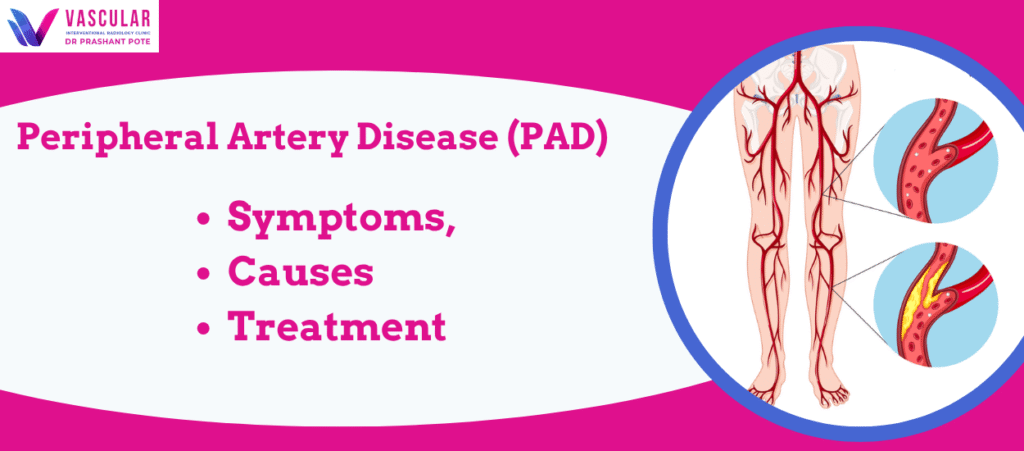
Peripheral Artery Disease (PAD) is a common but serious condition in which narrowed arteries reduce blood flow to the limbs — usually the legs. This restricted blood circulation can result in pain, mobility issues, and serious complications if not treated in time.
At Dr. Pote Vascular Clinic in Raipur, Dr. Prashant Pote, a trusted vascular and endovascular surgeon, offers expert diagnosis and treatment for PAD, helping patients regain mobility and prevent limb-threatening complications.
What is Peripheral Artery Disease?
PAD occurs when fatty deposits (plaques) build up in the artery walls — a process known as atherosclerosis. Over time, this narrows the arteries and limits blood flow to the limbs.
Although PAD can affect the arms, it most commonly targets the legs, leading to discomfort or cramping, particularly when walking or climbing stairs. This pain is known as claudication.
Common Symptoms of PAD
PAD may develop gradually and not cause obvious symptoms until significant artery narrowing has occurred. However, many patients experience symptoms such as:
- Leg pain while walking that goes away with rest
- Muscle cramps in the calves, thighs, or hips
- Numbness or weakness in the legs
- Coldness in one leg or foot
- Shiny skin or hair loss on the legs
- Slow-healing wounds or sores on the feet or toes
- Change in skin color (bluish or pale tone)
- Weak or absent pulse in the legs or feet
- Erectile dysfunction in men
In severe cases, pain can occur even at rest or during sleep, and sores may not heal, increasing the risk of gangrene.
What Causes Peripheral Artery Disease?
The primary cause of PAD is atherosclerosis — a buildup of cholesterol, fats, and other substances in the artery walls. These blockages reduce blood flow, leading to oxygen deprivation in the limbs.
Less common causes include:
- Inflammation of blood vessels (vasculitis)
- Trauma to the limbs
- Radiation exposure
- Muscle or ligament abnormalities
Who Is at Risk?
Several factors increase your risk of developing PAD:
- Smoking (the #1 modifiable risk factor)
- Diabetes
- High blood pressure
- High cholesterol
- Age 50+ with diabetes or smoking history
- Age 65 and older
- Family history of heart disease or stroke
- Obesity or physical inactivity
🔴 Smoking and diabetes together drastically increase the risk of PAD and leg amputation.
Complications of PAD
When left untreated, PAD can lead to serious consequences:
1. Critical Limb Ischemia (CLI)
This occurs when blood flow is severely restricted, causing painful ulcers, infections, or tissue death. CLI may lead to gangrene and leg amputation if not treated promptly.
2. Stroke and Heart Attack
The same atherosclerosis that causes PAD can also affect the arteries in your heart and brain, raising your risk for stroke and heart attack.
Diagnosis at Dr. Pote Vascular Clinic, Raipur
Dr. Prashant Pote uses advanced tools and tests to diagnose PAD early:
- Ankle-Brachial Index (ABI) – compares blood pressure in the ankle and arm
- Doppler Ultrasound – detects blood flow abnormalities
- CT Angiography / MR Angiography – to view detailed images of blood vessels
Early detection can help prevent serious complications.
How PAD is Treated
Treatment depends on the severity of the condition and your overall health. At Dr. Pote Vascular Clinic, PAD management is tailored to each individual.
1. Lifestyle Changes
- Quit smoking immediately
- Follow a heart-healthy diet
- Exercise regularly under supervision
- Control blood pressure, cholesterol, and blood sugar
2. Medications
- Blood thinners
- Cholesterol-lowering drugs
- Medications to improve walking ability
3. Minimally Invasive Procedures
When lifestyle changes and medication aren’t enough, Dr. Pote offers advanced procedures:
- Angioplasty and stent placement – to open narrowed arteries
- Atherectomy – to remove plaque buildup
- Bypass surgery – to reroute blood flow around blockages
How to Prevent PAD
The best way to prevent PAD or stop it from getting worse is to adopt a healthy lifestyle:
- Stop smoking — it is the most powerful risk factor you can control
- Eat a balanced diet rich in fruits, vegetables, and whole grains
- Exercise regularly (walking is a great start)
- Maintain a healthy weight
- Manage diabetes, blood pressure, and cholesterol
- Reduce stress and improve sleep habits
When to See a Vascular Surgeon
Don’t ignore leg pain or signs of poor circulation. Book an appointment with Dr. Prashant Pote if you:
- Experience cramping or pain when walking
- Notice slow-healing sores on your feet or legs
- Have cold or numb legs
- Are diabetic and over 50 years old
Early treatment prevents complications and improves quality of life.
Why Choose Dr. Pote for PAD Treatment in Raipur?
Dr. Prashant Pote is a leading vascular and endovascular surgeon in Raipur with extensive experience in managing complex PAD cases. Patients choose him for:
- Personalized, compassionate care
- Expertise in both conservative and surgical treatments
- Advanced, minimally invasive procedures
📍 Located at NH MMI Superspeciality Hospital, Pachpedi Naka, Raipur
📞 Contact: +91 7400628099
📧 Email: vascularclinic.raipur@gmail.com
🌐 Website: drpotevascular.com
Take the first step toward healthier legs. Don’t let PAD control your life — seek expert care today.
